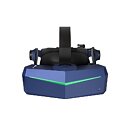Wednesday, December 2nd 2020
Pimax Launches 5K SUPER VR Headset with 180Hz Refresh Rate
Pimax, a VR hardware manufacturer known for innovative features such as extremely wide field of view and high resolution previously demoed a prototype VR headset at CES 2020 called the Pimax 5K SUPER together with Pimax new flagship headset the Pimax 8K X. Today Pimax is announcing the general availability of the new Pimax 5K SUPER, a refreshed version of the popular Pimax 5K Plus with a wide variety of updates.
The Pimax 5K SUPER features an Industry-leading high refresh rate with a standard 160Hz and even an experimental 180Hz mode along with an updated Modular Audio Strap (MAS) that allows much greater comfort and ease of use. The headset includes the popular Pimax comfort kit face cowling, Pimax nose guard, Pimax ruggedized housing system, and Pimax VR Experience software.Steam VR Lighthouse Tracking
The 5K SUPER is supported by both Steam VR 1.0 and 2.0 lighthouse tracking technology that allows for large room tracking up to 10 m x10 m, enabling the users to move freely in a big space with reliable tracking performance such as tracking consistency. Lighthouse tracking is the most advanced and accurate room-scale tracking system on the market today and allows tracking even when your controllers are below the waist, behind you or when they move close to the headset.
The NEW Pimax VR Experience Software
Pimax headsets now include the new Pimax VR Experience software which automates and dramatically reduces configuration time for VR software. This system automatically applies all VR optimizations required for Pimax headsets and can launch VR software from any platform with just a single click.
5K SUPER's Refresh Rate Breakthrough
The 5K SUPER with its standard refresh rate hitting 160Hz and even includes an experimental 180Hz mode, offers the user multiple selectable refresh rates and fields of view that set new standards for VR immersion. This amazing flexibility allows for the best possible experience with all VR titles available today. From watching movies to playing rapid reaction games out there the ideal refresh rate is easily selectable with a click. With our new breakthrough refresh rates fast-paced action appear buttery smooth and allow you to see ALL the action.
Pricing & Availability
The Pimax 5K SUPER is now available to purchase for 749 USD.
Source:
Pimax
The Pimax 5K SUPER features an Industry-leading high refresh rate with a standard 160Hz and even an experimental 180Hz mode along with an updated Modular Audio Strap (MAS) that allows much greater comfort and ease of use. The headset includes the popular Pimax comfort kit face cowling, Pimax nose guard, Pimax ruggedized housing system, and Pimax VR Experience software.Steam VR Lighthouse Tracking
The 5K SUPER is supported by both Steam VR 1.0 and 2.0 lighthouse tracking technology that allows for large room tracking up to 10 m x10 m, enabling the users to move freely in a big space with reliable tracking performance such as tracking consistency. Lighthouse tracking is the most advanced and accurate room-scale tracking system on the market today and allows tracking even when your controllers are below the waist, behind you or when they move close to the headset.
The NEW Pimax VR Experience Software
Pimax headsets now include the new Pimax VR Experience software which automates and dramatically reduces configuration time for VR software. This system automatically applies all VR optimizations required for Pimax headsets and can launch VR software from any platform with just a single click.
5K SUPER's Refresh Rate Breakthrough
The 5K SUPER with its standard refresh rate hitting 160Hz and even includes an experimental 180Hz mode, offers the user multiple selectable refresh rates and fields of view that set new standards for VR immersion. This amazing flexibility allows for the best possible experience with all VR titles available today. From watching movies to playing rapid reaction games out there the ideal refresh rate is easily selectable with a click. With our new breakthrough refresh rates fast-paced action appear buttery smooth and allow you to see ALL the action.
Pricing & Availability
The Pimax 5K SUPER is now available to purchase for 749 USD.



10 Comments on Pimax Launches 5K SUPER VR Headset with 180Hz Refresh Rate
It's nowhere near "5K" resolution. It's 1440p per eye.
HP Reverb G2 has 2160x2160 per eye which is much better than this Pimax "5K". But I guess according to Pimax their product has higher pixel count :D
I do have to give it to PiMax, they certainly do check all of the right boxes on their marketing slides to appear to be bleeding edge, however I would take an Index 10 out of 10 times even with the higher cost of the headset.